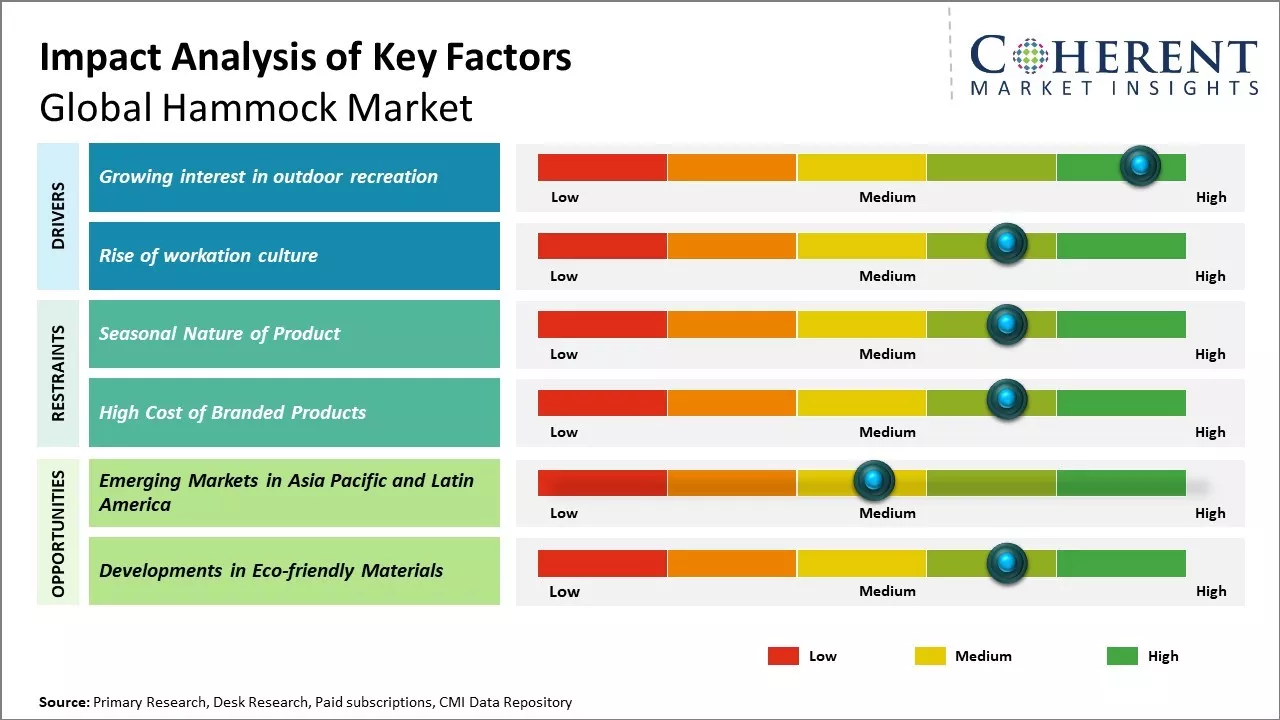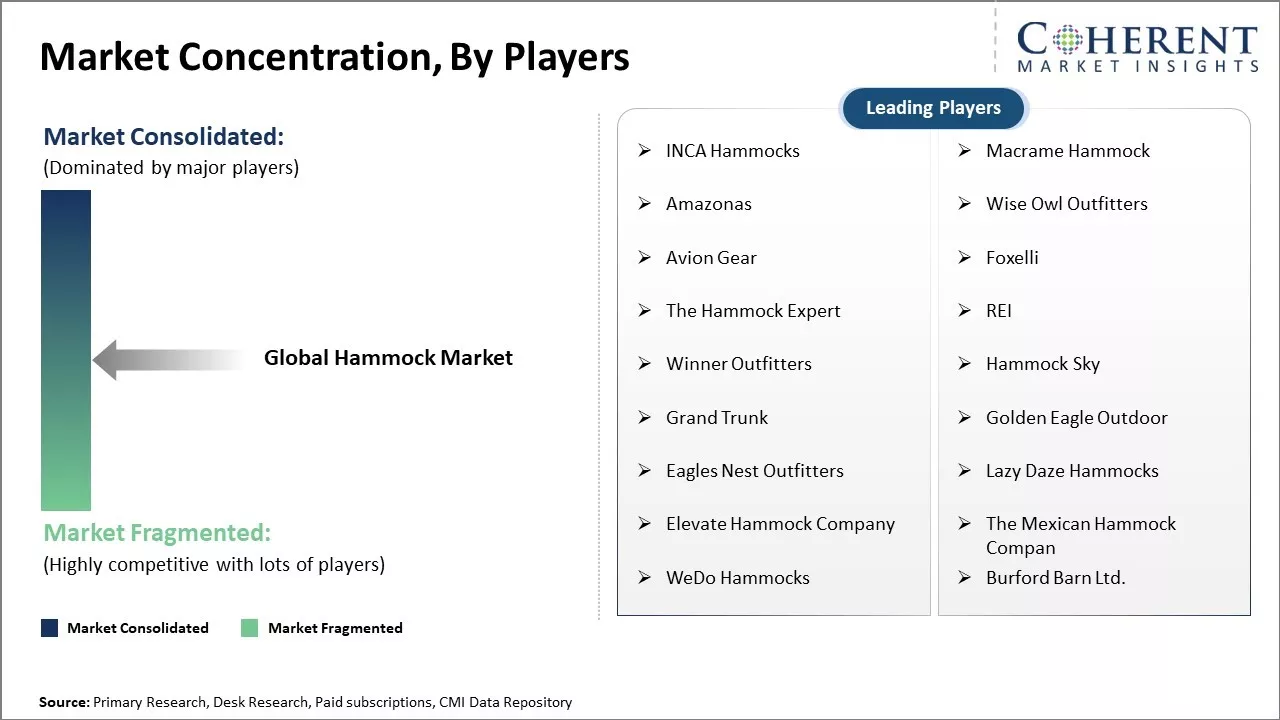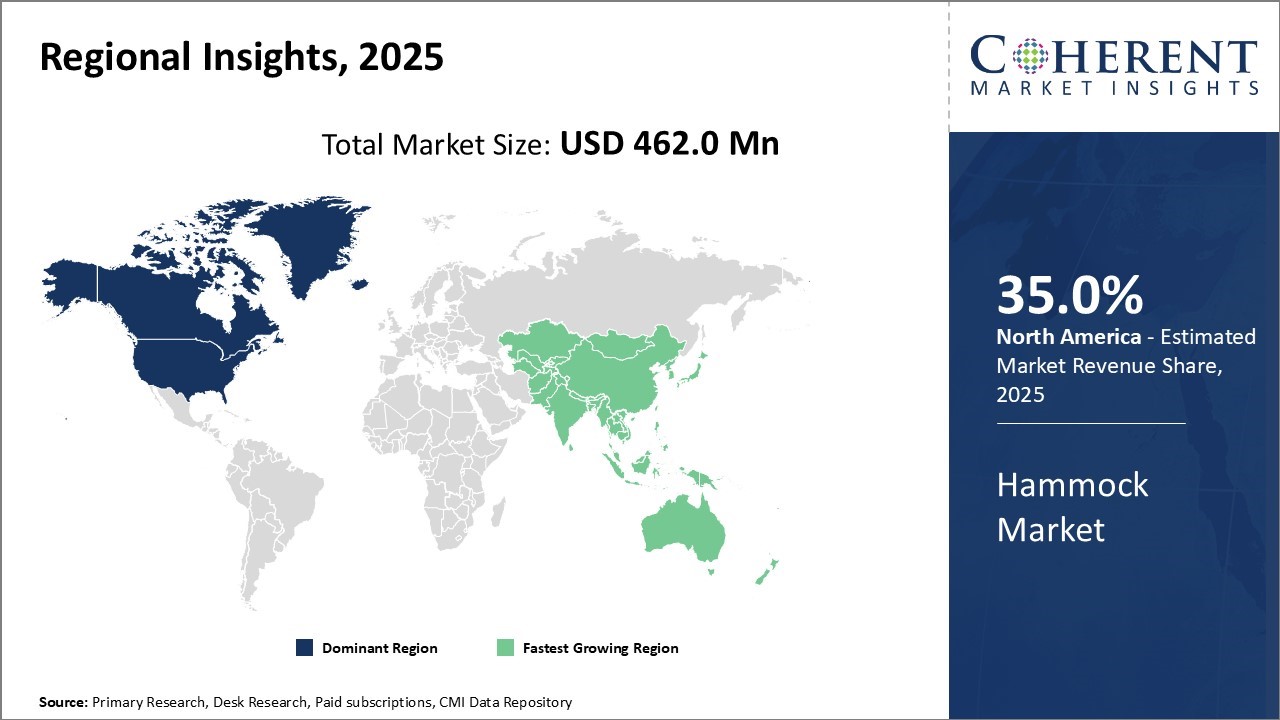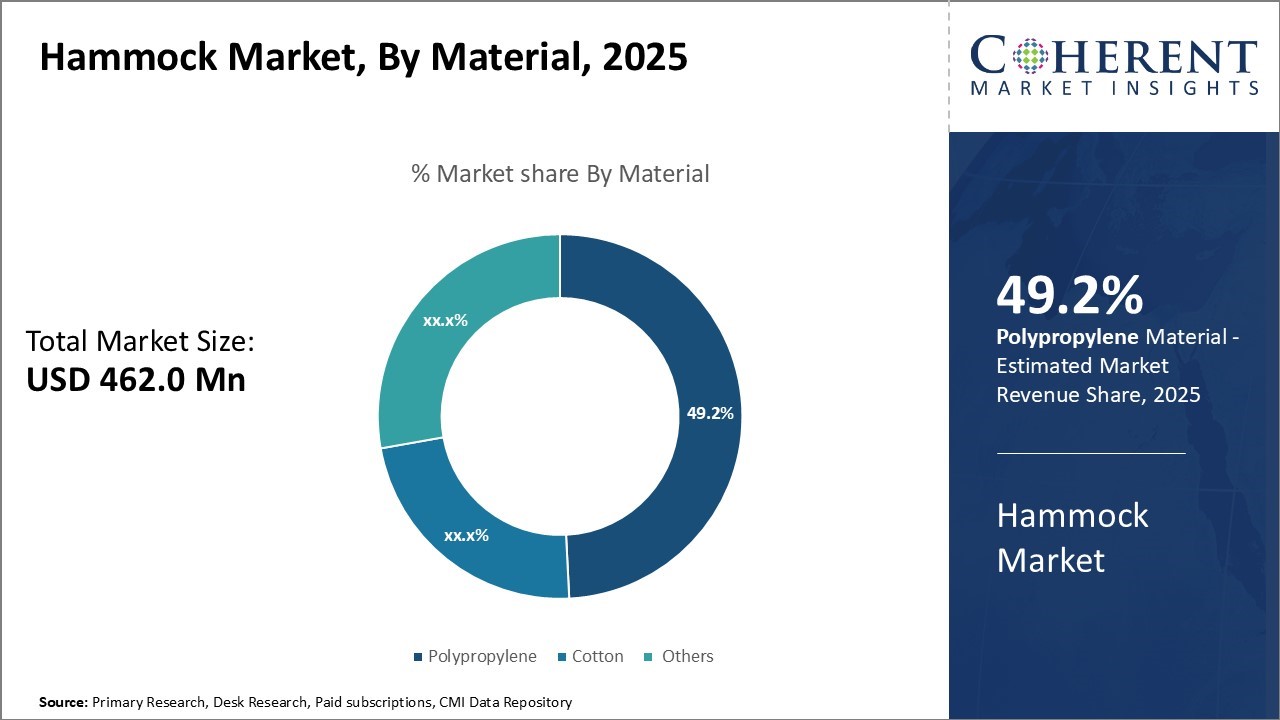Global Hammock Market Size and Forecast
The hammock market is estimated to be valued at USD 462.0 Mn in 2025 and is expected to reach USD 672.5 Mn by 2032, exhibiting a compound annual growth rate (CAGR) of 5.5% from 2025 to 2032.
Key Takeaways of the Global Hammock Market
- In terms of material, polypropylene is expected to contribute 49. 2% share of the hammock market in 2025.
- In terms of type, the conventional segment is expected to hold 74. 8% of the market share in 2025.
- In terms of sales channel, offline is expected to contribute 84% of the market share in 2025.
- North America region, holding 35. 0% market share in 2025 is expected to dominate the global hammock market.
Market Overview
The global hammock market has seen steady growth over the past few years. The demand for hammocks has increased mainly due to the rising popularity of outdoors activities and backyard relaxation.
Hammock camping and glamping have surged the product demand recently. In addition, the availability of lightweight and portable hammocks through e-commerce platforms coupled with rising disposable income of consumers in developing regions is fueling the market expansion. However, rising preference of consumers towards sustainable products may provide growth opportunities for manufacturers in the future.

To learn more about this report, Download Free Sample
Current Events and their Impact on the Global Hammock Market
|
Current Events |
Description and its impact |
|
Climate Disruptions Affecting Raw Material Supply
|
|
|
Trade Policy Shifts Reshaping Sourcing Strategies |
|
Uncover macros and micros vetted on 75+ parameters: Get instant access to report
Market Trends
Growing Interest in Outdoor Recreation
The growing interest in outdoor recreational activities has been fueling the demand for hammocks in recent years. Their portability and ease of setup allow people to hang one almost anywhere between two anchor points like trees. Popular activities like hiking, camping, and backpacking have seen a surge in participants as individuals and families seek ways to disconnect from technology and spend quality time in natural environments. Hammocks are lightweight and pack down to a small size, making them very convenient gear for casual days outdoors or extended wilderness trips.
The rise of social media has also played a role in popularizing hammocks. Pictures and videos shared on platforms like Instagram and Pinterest frequently feature beautifully shot scenes of people relaxing in hanging nets between trees with scenic backdrops. The ability to comfortably lounge while still taking in spectacular outdoor views has an appeal that perfectly suits the visual nature of social platforms. Hammock companies have further capitalized on this trend through clever marketing campaigns portraying an idyllic sense of calm and escape from daily life. As more people gain exposure to this lifestyle through online sharing, it normalizes the idea of hanging outdoors and drives curiosity to try hammocks for oneself. The growing interest in eco-conscious recreation also aligns with hammocks being a low-impact way to unwind surrounded by nature without needing specialized camping equipment or structures.
Rise of Workation Culture
Another key driver has been the emergence of "workation" or traveling specifically to work remotely in new environments. The pandemic significantly accelerated remote and hybrid work setups, blurring the lines between professional and personal spaces. Many employees and freelancers now have the flexibility to work from virtually anywhere with an internet connection. This has fueled interest in extended travel combining leisure and productivity. Destinations catering to digital nomads like coworking spaces, internet cafes, and remote work resorts have become popular. Hammocks perfectly meet the needs of this emerging demographic combining relaxation and a change of scenery with the ability to focus on tasks. Their portability also allows setting up a hanging workstation almost anywhere in nature like beaches, gardens, or patios.
For instance, some companies are integrating hammocks into office spaces to create relaxation zones, recognizing their benefits for employee well-being and productivity. This blending of work and leisure is evident in the growing popularity of "workations" in India, where individuals are shifting their workstations to scenic locations to enjoy nature while working remotely.
Market Opportunity: Emerging Markets in Asia Pacific and Latin America
The hammock market has a tremendous growth opportunity in the emerging markets of Asia Pacific and Latin America over the next few years. These regions have lucrative demographics and strong economic growth which is ideal for market expansion. Countries like India, Indonesia and Brazil have a very young population with over 60% under the age of 35 years. This young workforce is increasingly adapting to modern lifestyles and innovative leisure products. The rise of nuclear families and dual income households leaves less time for activities like camping or hiking which increases the appeal of hassle-free recreational gear like hammocks. Rapid urbanization is also driving the need for portable relaxation solutions for small urban homes and apartments.
The rise of nuclear families and dual‑income households leaves less time for activities like camping or hiking, which increases the appeal of hassle‑free recreational gear such as hammocks. To illustrate, in India, over 65% of the population is under 35, making it a prime market for portable leisure products.
Market Concentration and Competitive Landscape

To learn more about this report, Download Free Sample
Global Hammock Market Insights By Material
In terms of material, polypropylene is expected to contribute 49.2% share of the hammock market in 2025, owing to its superior comfort and durability. Polypropylene hammocks are light in weight yet incredibly strong, allowing them to support more weight than their cotton counterparts. The material is highly resistant to mildew, UV damage, and rotting, keeping hammocks looking fresh for many seasons of outdoor use. Polypropylene is also comfortable as it does not absorb moisture like cotton, keeping sleepers dry even in humid conditions. Its ability to retain shape over time further adds to long-term sleeping enjoyment. Consumers looking for a hammock that provides cushioned support without the bulk of heavier materials have come to rely on polypropylene's blend of softness, hardiness, and low maintenance qualities.
Global Hammock Market Insights By Type
In terms of type, the conventional segment is expected to hold 74.8% of the market share in 2025, owing to its straightforward, easy-to-use design. Conventional hammocks require no knowledge of spreader bars or complicated hanging techniques, making them accessible to all levels of users. Their simplicity means less hassle in setting up and adjusting the angle of recline. The archetypal banana shape also provides stable, cocoon-like comfort without risk of falling out even for restless sleepers. Many consumers appreciate the back-to-basics approach which allows focus on relaxing out in nature without fiddling with multiple components or support lines. The classic aesthetic also never goes out of style and remains suitable for all outdoors spaces from patios to forests. This perfect balance of functionality and aesthetics contributes to the enduring popularity of conventional hammocks.
Global Hammock Market Insights By Sales Channel
In terms of sales channel, offline is expected to contribute 84% of the market share in 2025 due to influential social and experiential factors. Shoppers enjoy touching and feeling the tactile qualities of different materials before purchase. Laying in display hammocks provides valuable insights into comparative comfort levels that online photos cannot replicate. Seeing hammocks hung with attachments provides confidence in setup. Offline retailers often host in-store "hang-out" sessions where customers can test product durability firsthand.
Social experiences like these festivals reinforce the hammock lifestyle and help introduce new users. Shop assistants provide expert face-to-face advice on pairing hammocks with stands or trees. Touchpoint try-outs and advice address concerns that may otherwise prevent online purchases. Even for enthusiasts, physical stores offer camaraderie through communal sharing of camping tips and tales. These social and experiential elements fuel ongoing demand through offline retail channels.
Regional Insights

To learn more about this report, Download Free Sample
North America Hammock Market Trends and Analysis
The North America region currently dominates the global hammock market. The region is expected to account for 35.0% of the market share in 2025. Hammock usage is deeply ingrained in the culture and lifestyle of many Americans, especially those living in warmer coastal regions. Several American companies have established an early-mover advantage in hammock manufacturing and distribution over the past few decades. Brand awareness for companies like Wise Owl Outfitters and Vivere is extremely high among consumers looking to purchase a hammock. Furthermore, retail outlets dedicated entirely to hammock sales have proliferated across the Southern U.S. Large retail chains like Cabella's and Bass Pro Shops devote significant floor space to hammock displays, giving consumers ample opportunity to interact with products before making a purchase decision. This extensive distribution network, combined with an established consumer preference for hammocks, has made North America the premier market globally.
Companies such as Recreational Equipment, Inc. (REI) have significantly contributed to North American hammock market growth through their strong brand presence and extensive distribution. For example, REI features camping and backyard hammock displays in over 180 of its stores across the U.S., boosting consumer exposure and sales via both in-store and e‑commerce channels.
Asia Pacific Hammock Market Trends and Analysis
The Asia Pacific region is set for rapid growth in hammock demand, driven by a history of usage in warm climates and increasing discretionary incomes in countries like India and Indonesia. Global hammock companies are expanding here through local manufacturing or retail partnerships. China is a key growth area, with its large middle class increasingly interested in outdoor recreation. International brands are capitalizing by offering affordable, high-quality products, while domestic manufacturers are improving to compete. This region is expected to eventually match North America as a global hammock market leader.
The Asia Pacific outdoor furniture market, which includes hammocks, is projected to exhibit a compound annual growth rate (CAGR) of approximately 7.1% from 2025 to 2030 indicating robust regional growth for related leisure products.
India Hammock Market Trends and Analysis
India hammock market is experiencing significant growth, driven by a historical affinity for hammocks in warm climates and rising discretionary incomes enabling leisure purchases. Rapid urbanization and a growing interest in outdoor relaxation are also key factors. For instance, the demand for hammocks in India is being fueled by an increasing shift towards outdoor leisure activities and a rising middle class willing to invest in products for backyard relaxation and home improvement, with online sales showing strong growth.
U.S. Hammock Market Trends and Analysis
The North American region, particularly the U.S., currently dominates the global hammock market due to hammocks being deeply ingrained in American culture, especially in warmer coastal areas. Established American companies and extensive retail networks contribute to high brand awareness and accessibility. For instance, major U.S.-based brands like Eagles Nest Outfitters (ENO) and Wise Owl Outfitters have achieved widespread recognition and strong sales due to their focus on lightweight, portable designs catering to the booming outdoor recreation market, including camping and hiking enthusiasts, who represent a significant portion of US consumers.
Germany Hammock Market Trends and Analysis
Germany hammock market is a robust and growing segment within Europe's outdoor living sector, driven by a strong cultural affinity for gardens and outdoor spaces, coupled with high disposable incomes. German consumers prioritize quality, sustainability, and ergonomic design in their outdoor furniture. This market is part of a larger trend where outdoor areas are increasingly viewed as extensions of indoor living. For instance, the Germany outdoor furniture market, which includes hammocks is expected to exhibit a compound annual growth rate (CAGR) of 6.8% from 2025 to 2030. This growth indicates a continued strong demand for leisure products that enhance outdoor relaxation and well-being in the country.
China Hammock Market Trends and Analysis
China hammock market is experiencing significant expansion, primarily fueled by the rapid growth of its middle class, increasing urbanization, and a burgeoning interest in outdoor leisure activities and home-centric relaxation solutions. While traditional hammock usage might have been lower compared to other Asian regions, the modern Chinese consumer is increasingly embracing innovative leisure products that enhance lifestyle and well-being.
Market Report Scope
Hammock Market Report Coverage
| Report Coverage | Details | ||
|---|---|---|---|
| Base Year: | 2024 | Market Size in 2025: | USD 462.0 Mn |
| Historical Data for: | 2020 To 2024 | Forecast Period: | 2025 To 2032 |
| Forecast Period 2025 to 2032 CAGR: | 5.5% | 2032 Value Projection: | USD 672.5 Mn |
| Geographies covered: |
|
||
| Segments covered: |
|
||
| Companies covered: |
INCA Hammocks, Macrame Hammock, Amazonas , Wise Owl Outfitters, Avion Gear, Foxelli, The Hammock Expert, REI, Winner Outfitters, Hammock Sky, Grand Trunk, Golden Eagle Outdoor, Eagles Nest Outfitters, Lazy Daze Hammocks, Elevate Hammock Company, The Mexican Hammock Company, WeDo Hammocks, and Burford Barn Ltd. |
||
| Growth Drivers: |
|
||
| Restraints & Challenges: |
|
||
Uncover macros and micros vetted on 75+ parameters: Get instant access to report
Global Hammock Industry News
- Kammok, featured "Black Friday 2024 Bundles" on its website, indicating continued product offerings and marketing efforts in late 2024.
- On February 3, 2025, Tensa Outdoor updated the Tensa4 stand with its seventh production run designed to support 350 lb loads and 12‑ft hammocks-offering a freestanding modification for users without suitable trees.
- In December 2024, ENO released news articles on their website addressing common questions about their Parklite Hammock Chair Stand.
- In October, 2024, Go Ape USA entered into a partnership with Tentsile to introduce new tree-top adventure experiences using tree tents and hammocks.
- In April 2024, Divine One Group partnered with Devmark, the U.A.E.’s leading real estate project sales and marketing consultancy, to launch Hammock Park, a resort-inspired residence in Wasl Gate, just minutes away from Sheikh Zayed Road.
Consumer Behavior Analysis
- Consumer behavior in the hammock market is increasingly shaped by evolving lifestyle trends, rising demand for relaxation solutions, and a growing emphasis on outdoor and home leisure. The market is witnessing a significant shift as consumers prioritize comfortable, versatile, and aesthetically pleasing options for both indoor and outdoor use. The rise of compact living spaces and the desire for portable relaxation solutions have also led to a preference for hammocks that offer ease of installation and diverse functional features.
- End-use preferences are diverse, with significant demand from urban residents seeking relaxation solutions for residential spaces (backyards, balconies) and outdoor enthusiasts using hammocks for camping or beach activities. North America remains a leading market due to its established outdoor culture and high disposable income, while Asia Pacific is emerging as a fast-growing region driven by rapid urbanization and increasing adoption of modern leisure products.
Emerging Applications
- Hammocks are increasingly being adopted in niche areas like healthcare for therapy and mobility, in urban planning for public relaxation spaces, and as premium features in luxury resorts.
- Future applications for hammocks include rapid-deployment systems for disaster relief and integration into workplace wellness programs as nap pods.
- Long-term concepts are exploring hammock-based sleeping compartments within electric buses and autonomous vehicles for sustainable travel solutions.
Market Segmentation
- Material Insights (Revenue, USD Mn, 2020 - 2032)
- Cotton
- Polypropylene
- Others
- Type Insights (Revenue, USD Mn, 2020 - 2032)
- Spreader bar
- Conventional
- Sales Channel Insights (Revenue, USD Mn, 2020 - 2032)
- Offline
- Online
- Regional Insights (Revenue, USD Mn, 2020 - 2032)
- North America
- U.S.
- Canada
- Latin America
- Brazil
- Argentina
- Mexico
- Rest of Latin America
- Europe
- Germany
- U.K.
- Spain
- France
- Italy
- Russia
- Rest of Europe
- Asia Pacific
- China
- India
- Japan
- Australia
- South Korea
- ASEAN
- Rest of Asia Pacific
- Middle East & Africa
- GCC Countries
- Israel
- Rest of Middle East & Africa
- Key Players Insights
- INCA Hammocks
- Macrame Hammock
- Amazonas
- Wise Owl Outfitters
- Avion Gear
- Foxelli
- The Hammock Expert
- REI
- Winner Outfitters
- Hammock Sky
- Grand Trunk
- Golden Eagle Outdoor
- Eagles Nest Outfitters
- Lazy Daze Hammocks
- Elevate Hammock Company
- The Mexican Hammock Company
- WeDo Hammocks
- Burford Barn Ltd.
Sources
Stakeholders
- Hammock manufacturers
- Outdoor furniture distributors
- Retail chain buyers
- Industry experts
- Others
Magazines
- Furniture Today
- Outdoor Living
- Home & Garden Design
- Leisure Retailer
- Others
Journals
- Journal of Outdoor Recreation and Tourism
- International Journal of Consumer Studies
- Journal of Business Research
- Others
Newspapers
- The Wall Street Journal
- Financial Times
- Bloomberg
- The Economic Times
- Others
Associations
- American Home Furnishings Alliance (AHFA)
- Hammock Manufacturers Association
- International Casual Furnishings Association (ICFA)
- Outdoor Industry Association
- Others
Public Domain sources
- U.S. Census Bureau, World Bank
- United Nations Comtrade Database
- Environmental Protection Agency (EPA)
- Others
Proprietary Elements
- CMI Data Analytics Tool
- Proprietary CMI Existing Repository of information for last 8 years
Share
Share
Missing comfort of reading report in your local language? Find your preferred language :
Transform your Strategy with Exclusive Trending Reports :
Frequently Asked Questions
EXISTING CLIENTELE
Joining thousands of companies around the world committed to making the Excellent Business Solutions.
View All Our Clients


